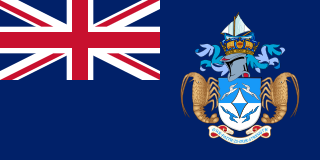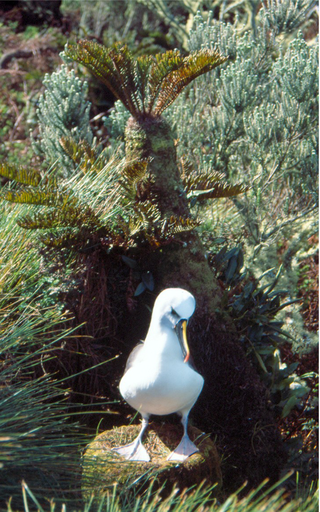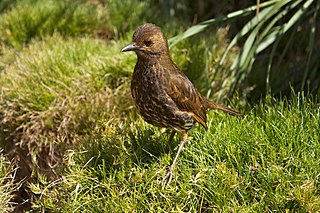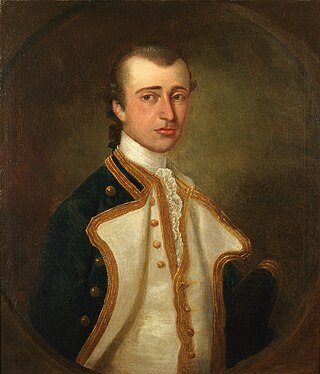
Saint Helena is an island in the South Atlantic Ocean, about midway between South America and Africa. St Helena has a land area of 122 square kilometres and is part of the territory of Saint Helena, Ascension and Tristan da Cunha which includes Ascension Island and the island group of Tristan da Cunha.

Tristan da Cunha, colloquially Tristan, is a remote group of volcanic islands in the South Atlantic Ocean. It is the most remote inhabited archipelago in the world, lying approximately 2,787 kilometres (1,732 mi) from Cape Town in South Africa, 2,437 kilometres (1,514 mi) from Saint Helena, 3,949 kilometres (2,454 mi) from Mar del Plata in Argentina, South America and 4,002 kilometres (2,487 mi) from the Falkland Islands.

The Inaccessible Island rail is a small bird of the rail family, Rallidae. Endemic to Inaccessible Island in the Tristan Archipelago in the isolated south Atlantic, it is the smallest extant flightless bird in the world. The species was described by physician Percy Lowe in 1923 but had first come to the attention of scientists 50 years earlier. The Inaccessible Island rail's affinities and origin were a long-standing mystery; in 2018 its closest relative was identified as the South American dot-winged crake, and it was proposed that both species should be nested within the genus Laterallus.

Gough Island, also known historically as Gonçalo Álvares, is a rugged volcanic island in the South Atlantic Ocean. It is a dependency of Tristan da Cunha and part of the British overseas territory of Saint Helena, Ascension and Tristan da Cunha. It is about 400 km (250 mi) south-east of the Tristan da Cunha archipelago, 2,400 km (1,500 mi) north-east from South Georgia Island, 2,700 km (1,700 mi) west from Cape Town, and over 3,200 km (2,000 mi) from the nearest point of South America.

Inaccessible Island is a volcanic island located in the South Atlantic Ocean, 31 km (19 mi) south-west of Tristan da Cunha. Its highest point, Swale's Fell, reaches 581 m (1,906 ft), and the island is 12.65 km2 (4.88 sq mi) in area. The volcano was last active six million years ago and is currently extinct.

Nightingale Island is an active volcanic island in the South Atlantic Ocean, 3 square kilometres (1.2 sq mi) in area, part of the Tristan da Cunha group of islands. They are administered by the United Kingdom as part of the overseas territory of Saint Helena, Ascension and Tristan da Cunha.

Edinburgh of the Seven Seas is the only settlement on the island of Tristan da Cunha, a part of the British Overseas Territory of Saint Helena, Ascension and Tristan da Cunha in the South Atlantic Ocean. Locally, it is referred to as The Settlement or The Village.

The Nightingale Islands are a group of three islands in the South Atlantic Ocean, part of the Tristan da Cunha territory. They consist of Nightingale Island, Middle Island and Stoltenhoff Island. The islands are administered by the United Kingdom as part of the overseas territory of Saint Helena, Ascension and Tristan da Cunha. The Nightingale Islands are uninhabited.

The Atlantic yellow-nosed albatross is a large seabird in the albatross family Diomedeidae.

Stoltenhoff Island is a small uninhabited island in the South Atlantic Ocean, part of the Nightingale Islands. It is the smallest of the Nightingale Islands, and is to the north west of Nightingale Island itself. They are governed as part of Tristan da Cunha, an archipelago and part of the British overseas territory of Saint Helena, Ascension and Tristan da Cunha. The island is part of the Nightingale Islands group Important Bird Area (IBA), identified as such by BirdLife International as a breeding site for seabirds and endemic landbirds.
Saint Helena, Ascension Island and Tristan da Cunha, as well the other uninhabited islands nearby, are a haven for wildlife in the middle of the Atlantic Ocean. The islands are or were home to much endemic flora and fauna, especially invertebrates, and many endemic fish species are found in the reef ecosystems off the islands. The islands have been identified by BirdLife International as Important Bird Areas for both their endemic landbirds and breeding seabirds.

The Tristan thrush, also known as the starchy, is a species of bird in the thrush family that is endemic to the British overseas territories of the isolated Tristan da Cunha archipelago in the South Atlantic Ocean.

The following outline is provided as an overview of and topical guide to Tristan da Cunha:

Saint Helena, Ascension and Tristan da Cunha is a British Overseas Territory located in the South Atlantic and consisting of the island of Saint Helena, Ascension Island, and the archipelago of Tristan da Cunha. Its name was Saint Helena and Dependencies until 1 September 2009, when a new constitution came into force giving the three islands equal status as three territories, with a grouping under the Crown.

Tristan da Cunha is an archipelago of five islands in the southern Atlantic Ocean, the largest of which is the island of Tristan da Cunha itself and the second-largest, the remote bird haven, Gough Island. It forms part of a wider territory called Saint Helena, Ascension and Tristan da Cunha which includes Saint Helena and Ascension Island.
The MS Oliva was a bulk carrier launched in 2009. On 16 March 2011, due to the risky navigation of trying to achieve the minimal allowed clearance of Nightingale Island of 10 nmi, and due to human error in navigation reducing the actual clearance to zero, the ship went aground off Nightingale Island, Tristan da Cunha, in the South Atlantic, at 4 am while on a voyage from Santos, Brazil to China with a cargo of soya beans.

Sandy Point is the easternmost extremity of the island of Tristan da Cunha in the South Atlantic Ocean. It is a distance of about 7 miles (12 km) by sea from the island's only settlement, Edinburgh of the Seven Seas. There is a beach of black volcanic sand fringed by low cliffs and a sloping plateau leading up to Tristan's mountainous interior. Its climate is warmer and drier than that of the Settlement, being in the lee of the island's prevailing winds.
St. Mary's Church is a religious building belonging to the Church of England in the town of Edinburgh of the Seven Seas on the island of Tristan da Cunha, one of those that make up the British overseas territory of Saint Helena, Ascension and Tristan da Cunha in the Southern Atlantic Ocean.

The Tristan da Cunha–Gough Islands shrub and grasslands is a terrestrial ecoregion which covers the Tristan da Cunha archipelago and Gough Island in the South Atlantic Ocean. The islands' remote location gave rise to many endemic species.

Captain Sir Gamaliel Nightingale, 9th Baronet was an English landowner and Royal Navy officer.













